Kamis, 30 September 2010
We take on Britcar 24-hour race at Silverstone in a near-standard Mazda MX-5.
Britain’s only 24-hour sportscar race has a bumper 60-car entry and our man is driving a lightly-modified Mazda MX-5 in the production class.
Owen will share the car, entered by Team Jota Mazda UK, with experienced racer Mark Ticehurst and Ollie Marriage from sister magazine Evo.
The 2.0-litre roadster has a standard engine and gearbox but mildly upgraded suspension, an endurance fuel tank and full safety roll cage.
Aside from our MX-5, other Britcar 24-hour race highlights include the endurance debut of the factory Lotus Evora GT4, while other drivers taking part include WTCC driver Rob Huff and ex-Honda F1 tester James Rossiter.
Our man will be Twittering throughout the race, so make sure you check back here for live updates and pictures from the race.
Selasa, 20 Juli 2010
Subaru Impreza WRX STI sedan
Yes, the 2008 STI was smoother and quieter. It also felt softer and easier to drive, even--and this was the depressing part--tame in comparison with the original. Some of that feeling was simply perception born from inevitable refinement, but it remained in place to some degree even as Subaru's engineers improved the car's suspension and engine for 2009, with even more suspension upgrades added to last year's STI Special Edition. Unfortunately for the product planners and the early adopters, this is often the case when an inspiring machine evolves, especially one that arrived on the scene providing a driving experience so genuine that it earned a diverse loyalist following spanning traditional gearheads, rally nuts and the sterotypical street-racer fan boys trained on PlayStation more than their local road courses.
Two and a half years later, Subaru does not feel a need to apologize for the last STI, as sales have remained relatively stable at around 3,000 to 3,500 cars sold per year. It does, however, acknowledge “a difference in [company] philosophy when that car was launched,” as one spokesman said on the eve of the 2011 model's introduction. “You can't please everybody.”
No, but first drives of the new WRX and WRX STI indicate that Subaru has come much closer to doing so this time around.
The most obvious distinction is the return of a sedan, which joins the five-door hatchback in the STI lineup. Subaru has always offered a four-door version of the WRX but binned the STI sedan for 2008 because it wanted to sell potential buyers on a direct link between the road car and the hatchback-based World Rally Championship contender of the time. Still, while the five-door's shorter overhangs made it easier for WRC driver Petter Solberg to know where his rally car's corners were, and therefore keep it in one piece at speed through the forests of Wales and the snow banks of Finland, the design failed to resonate with a fair portion of hard-core customers.
“Consumer feedback [said] that a lot of people didn't like the hatch; a lot wanted the sedan,” Subaru's spokesman said. “When we took that away, [some thought the car was] too mild, too mellow.”
There is far less chance of that now, even if you still feel that the latest design lacks the original's raw visual impact and apparent singularity of purpose. The WRX and STI sedans and hatches now share aggressive, wide-body panels. The appearance is all new to Impreza sedans, while revised lightly in the front on five-door versions. To distinguish the STI as the top-of-the-line edition, the sedan once again flaunts a tall signature rear wing, now noticeably convex in sculpting, and all STIs receive bigger wheels and tires and, of course, STI badging.
If you were hoping for increased power, you'll want to skip the following section, as engines and transmissions remain unchanged. The WRX's 2.5-liter turbocharged boxer four still features maximum boost pressure of 14.2 psi and produces 265 hp at 6,000 rpm and 244 lb-ft of torque at 4,000. The STI engine, with 14.7 psi of boost, remains rated at 305 hp at 6,000 rpm and 290-lb-ft at 4,000. Subaru engineers say that the WRX still runs from 0 to 60 mph in 5.4 seconds, the STI in 4.9. Experience shows that Subaru's official acceleration numbers tend to fall into the conservative zone, though; as with the old cars, you should be able to shave 0.2 to 0.3 second from those times. Officially, the WRX tops out at 142 mph, while the STI sedan's improved aerodynamics bump its top speed to 158 mph, 3 mph faster than the hatchback.
Straightline running, though, is not what will make this generation of cars memorable or significant to the lineage, as they feel identical to their predecessors when you crack the throttle in pursuit of pure velocity. And as nice as the wide-body design and mildly reworked interior are (there's a new audio system and instrument cluster, and STIs are now available with leather seats and power moonroof in Limited trim), that's not enough to earn them a new chapter in the Book of Impreza. But what lies underneath just might, as it positively improves the handling with seemingly no reduction in ride quality.
According to Hiroshi Mori, the cars' general manager, “all [mechanical] changes for 2011 [are intended] to improve driver confidence, handling and response.” Initial impressions from a day behind the wheel of the WRX and STI say that he and his team achieved their target.
The key modifications lie within the suspension, which features a wider track (by 1.3 inches in front, 1.5 rear) made possible by the flared bodywork. WRX wheel and tire sizes increase as well, with 17- x 8-inch wheels versus the previous edition's 17 x 7. Tires measure 235/45, up from 225/45. As for the STI, wheel size carries over (18 x 8.5), as does tire size (245/40). The WRX also receives firmer rear suspension subframe bushings, and our brief drive on Colorado mountain roads indicates that there is less body roll through corners to go along with more grip.
Extended time in the STI, though, reveals the real performance story. Mori's engineers fitted the front suspension with a feature well known to racers and aftermarket performance-part junkies. “Pillow ball” bushings—or spherical bearings, if you prefer—attach the aluminum lower control arms to the front suspension's subframe. Whereas the old STI used economical rubber bushings with steel sleeves, the new design's proper steel bearings provide twice as much resistance to fore/aft forces and improve camber and toe stiffness.
From there, it's a trickle-down effect throughout the suspension. Front spring rate increases by 15.6 percent, the rear by an impressive 53 percent over the standard 2010 STI and 18 percent versus the aforementioned STI Special Edition. Antiroll bars are slightly larger (21 millimeters versus 20 in front, 19 versus 18 out back), and the ride height drops by 5 millimeters. Mori says that the STI now generates 0.93 g of maximum lateral grip compared with the 2010's 0.90, and there is 33 percent less body roll. The collective changes and newfound rigidity make better use of the front tires, which previously suffered high wear on the outer third of their tread.
Your backside relays the message better than any numbers on a chart ever could. Our drive on the road indicated improvements in grip, dive, roll and corner turn-in, with the STI taking a quicker, firmer and more confidence-inspiring attitude through corners that will be apparent to drivers of varying skill levels—just as Mori said.
Back-to-back drives in 2010 and 2011 STIs on Aspen Motorsports Park's twisting layout confirmed those feelings. While the 2010 car's tires roared in tortured pain, the 2011's rubber only chirped, even during deliberate attempts to push harder and harder in order to unsettle the chassis, to find the spot when an inherent “softness” emerged as it did in the old car. Such a scenario never happened. Front-end bite is much better, with less understeer and improved grip through all phases of cornering. The new STI appears to handle lateral transitions significantly better than the old, and without doubt, the difference between the two generations was indisputably laid bare.
As this was a first drive, plenty remains to be discovered about the latest WRX and STI. There are many more miles to cover in the real world before we have a definitive sense of whether Subaru has taken a major step toward rediscovering the line's old magic. But if initial impressions prove correct, there's only one thing to say about the previous incarnation.
It's history.
2011 Subaru Impreza WRX
On Sale: Late August/early September
Base Price: $26,220
Drivetrain: 2.5-liter, turbocharged, 265-hp, 244-lb-ft H4; AWD, five-speed manual
Curb Weight: 3,208 lb
0-60 MPH: 5.4 sec (mfr)
Fuel Economy (EPA): 21 mpg
2011 Subaru Impreza WRX STI
On Sale: Late August/early September
Base Price: $34,720
Drivetrain: 2.5-liter, turbocharged, 305-hp, 290-lb-ft H4; AWD, six-speed manual
Curb Weight: 3,384 lb
0-60 MPH: 4.9 sec (mfr)
Fuel Economy (EPA): 19 mpg
Rabu, 02 Juni 2010
Ford SYNC with Applink

Ford's excellent SYNC infotainment technology is undoubtedly already one of the best systems on the market. But there's clearly been one glaring omission that's been keeping the Microsoft-developed system from attaining its true position as the ultimate automotive killer app that the world has been waiting for: horoscopes.
Good news, all you budding astrologers... Ford has seen fit to add daily horoscopes to all Ford, Lincoln and Mercury vehicles equipped with the cloud-based SYNC app Traffic, Directions & Information (TDI). There's no cost and all the driver needs are an active owner account on www.syncmyride.com and a Bluetooth-enabled cell phone.
Horoscopes not your thing? No problem! There will also be access to stock quotes, movie listings, airlines, rental cars and hotels. If this kind of thing tickles your
Senin, 12 April 2010
Volvo Introduces Race Version of All-New S60 Sedan with Mid-Mounted V6

The all-new 2011 S60 sedan was only just introduced to the public at the Geneva Motor Show in March, but Volvo has already prepared a racing version that will enter the2010 season of the Belgian Touring Car Series (BTCS).
The new S60 racer was developed locally by Volvo's Belgian S60 Racing Team in accordance with the BTCS Silhouette S1 regulations. All cars participating in the series must use a tubular chassis, the same type of front and rear suspension and aerodynamics.
Volvo's proposal features a mid-mounted 3.5-liter V6 engine with 410-horsepower and 412 Nm of torque at 5,500rpm. A six-speed sequential gearbox drives the rear-wheels.
The Swedish sedan's maiden track test took place on April 1 on the Belgian Zolder track, while its racing premiere takes place on April 11.



Minggu, 17 Januari 2010
maintains the Supra's six-cylinder powerhouse

Lexus' offerings for the 2010 Tokyo Auto Salon included a lightweight concept version of the firm's performance-minded sports sedan. Dubbed IS F Circuit Club Sport or CCS for short, the prototype Lexus comes in an attention-grabbing bright orange finish and more carbon fiber than a NASA warehouse.
 And we're talking about a lot of carbon fiber as the lightweight material is used for the newly designed hood, rooftop, rear wing, exterior mirrors, trunk, front spoiler lips, right down to the rear diffuser.
And we're talking about a lot of carbon fiber as the lightweight material is used for the newly designed hood, rooftop, rear wing, exterior mirrors, trunk, front spoiler lips, right down to the rear diffuser.
The same material is also found on the Lexus IS F's engine cover as well as in the interior on the door panels, center and lower console, steering wheel trim, and the transmission lever.
Unfortunately, Lexus did reveal the weight gains from the extensive use of carbon fiber parts on the sports car.
Other mods include the forged magnesium wheels and sport tires, high-performance carbon ceramic brakes, sport suspension, new exhaust system with a titanium sports muffler and the two-tone bucket seats inside.
Lexus said that the standard IS F's 5.0-liter V8 engine with 423HP (in JDM spec) has been left intact.
Photos by Phil Alex with the help of friends Mike and Aaron











the lower bumper is the most heavily modified part of the E92 LCI
Judging by the photos and information released, the general consensus is that BMW is looking to align some of its models to the current design language, and features like “angel eyes” are starting to become standard across the line-up. LED taillights are also becoming the norm at BMW and the new 3 Series LCI comes to emphasize that.
Exterior:
Regarding the exterior of the car – BMW, like they did with the pre-LCI E92, have managed to make the E92 continue to look much more expensive than it actually is. The facelifted E92 continues to give a strong balance between prestige and performance purely in appearance alone.
Additionally, at front and rear, while the revisions appear minimal, the proof is in the details. At the business end of the 3 Series Coupe, the head lamps have grown slightly with added contours to the bottom line of the head lamp assembly. A thin “eyebrow” can now be found running along the top of each assembly which is lit by LEDs – a design cue taken straight from the E90 LCI, F01 7 Series and F10 5 Series.
Dropping just below the head lamps, the lower bumper is the most heavily modified part of the E92 LCI, losing the struts that flowed with the cut lines of the nose of the car. In its place, BMW have added a slim cut straight across the center of the lower grill, only being broken up by the area just below the larger, wider double kidney grill. Overall, the appearance of the E92 LCI now looks more succinct with the rest of the now more modern BMW line-up.
Moving to the rear of the car, the lower portion of the bumper receives a larger, purposeful crease along the valence just above the exhaust. The L-shaped tail lamps also receive a mild facelift with a more opaque cover to the LEDs when compared to the pre-LCI E92.
Additionally, the pattern of the rear lamp LEDs has two stacked sets of LEDs to provide better visibility at night while also providing a distinctly BMW look. By comparison, the LCI E92 now looks much brighter and contoured over its predecessor.
The side design goes through some changes as well, the E92 LCI features longer overhangs and subtle changes to the side skirts, giving the facelift an overall more aggressive, masculine look.
Read Article
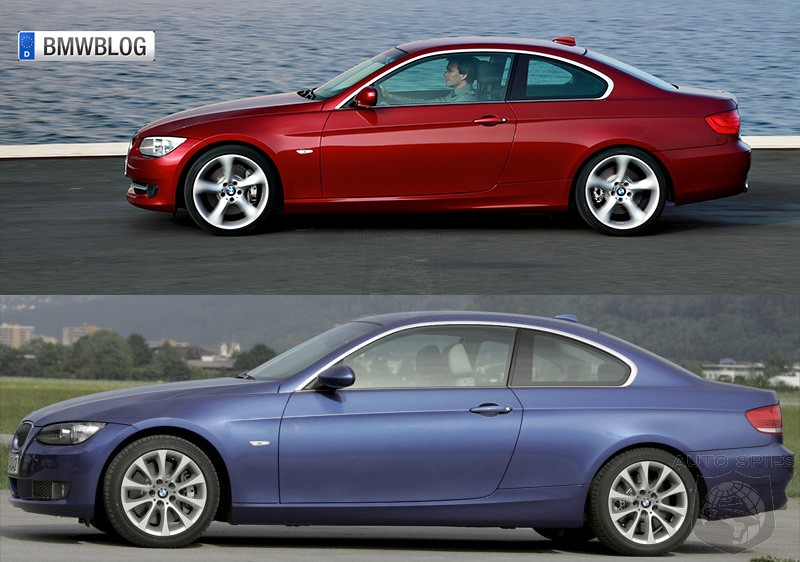
Kamis, 07 Januari 2010
but a bone-stock, 2011 Kia Sorento
![We Take Kia and Microsoft's UVO for a Test Drive [w/video]](http://www.blogcdn.com/www.autoblog.com/media/2010/01/kia-press-2010107-1024-08-630.jpg)
Tucked in between Google's hot new smartphone and a variety of other computer peripheral equipment at this year's CES show is a crossover. Not the jacked-up, tricked-out, neon-dragging customized type that we typically see around the Consumer Electronics Show, but a bone-stock, 2011 Kia Sorento. Well, stock except for one option: UVO.
We recently got a chance to try out the newly-announced system in the plastic, and while impressive in its own right, just hours after sitting down with Ford to check out the latest Sync and MyFord Touch, it's somewhat less than stunning. But, ignoring that for now, Kia's offering looks good and still ahead of the rest of the curve. It's functionally comparable to early Sync, enabling easy access to media on 1GB of internal storage, on a USB-connected drive or even on a CD. You can rip from CD straight to internal memory or to a thumb drive, an interesting feature we're not sure is particularly useful. The touchscreen display is a nice improvement over Ford's two-line Sync readout, but remember that if you get this system, you'll have to opt out of in-dash GPS. Good thing you splurged and got that Droid, right? Check out some screens in the gallery below, and there's a quick video demo after the break.
Kia and Microsoft's UVO
Our spies captured this facelifted C-Class

Subtlety is the key for Mercedes. Our spies captured this facelifted C-Class testing with only a few minor styling updates over the model it replaces. Most noticeable are the re-designed bumper, headlights and wheels.
Despite the similar looks, it's likely that Mercedes will offer a refreshed interior and a host of mechanical updates to improve efficiency and reduce emissions. Among these changes we can expect to see direct fuel injection and a stop-start system, as well as an ultra efficient BlueTec diesel engine.
Reports suggest that there may also be a new C-Class Coupe added to the range, which will replace the smaller CLC.
The facelifted C-Class is likely to be unveiled at the Los Angeles Motor Show in December.
Minggu, 03 Januari 2010
Honda make a road going version of this car
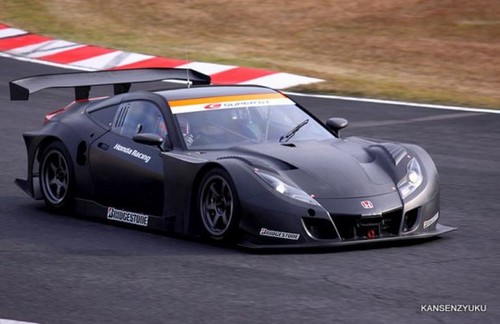
Honda’s new GT race car, the HSV-010 is the center of attention these days because it is the successor of the legendary NSX. Powered by a 3.4-liter V8 developing 500hp, the HSV will be competing in this season of Japanese SuperGT. Recently the car’s been scooped at Suzuka race track flexing its muscles a bit, showing off an awesome look. Check out that single central exhaust pipe! If Honda make a road going version of this car, it’ll be a Lexus LF-A killer!
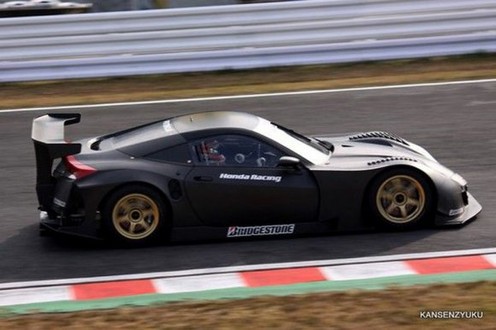
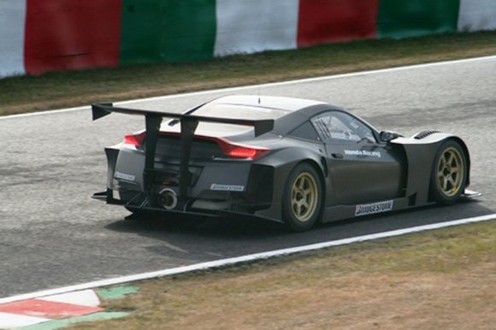
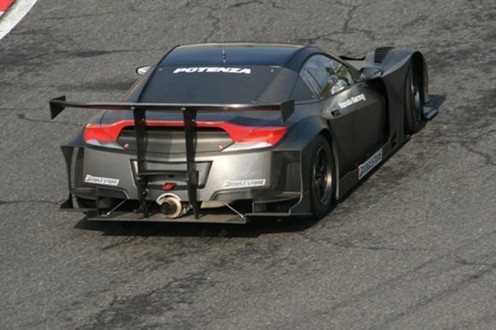
Watch the videos below to see the car in action:
kansenzyuku






